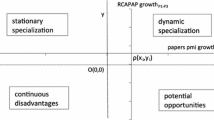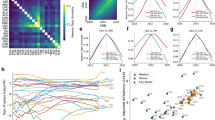Abstract
This paper seeks to compare the research priorities of thirty three countries in five macrofields (Physics, Chemistry, Biology, Mathematics and Engineering & Technology) in two time spans: 1980–1984 and 1985–1989. Comparative analysis is based on the distribution of publications in different fields. Since the raw counts of publications are confounded by the size of the countries and the size of the subject fields, a relative index — Research Priority Index (PI) — is computed for cross-national comparisons. Correspondence analysis is applied to the asymmetrical matrices of priority profiles to reveal the structure of multivariate relationships between countries and fields. The configurations for the two time-spans, obtained through correspondence analysis, are compared to reveal the dynamics of research priorities of these countries.
Similar content being viewed by others
Notes and references
T. Ojasco, J. C. Dore', J. F. Miquel, Regional cindrella,Nature, 70 (1994) 172.
R. Barre', A strategic assessment of the scientific performance of five countries,Science and Technology Studies, 5 (1987) 32–38.
B. R. Martin, J. Irvine, P. A. Issard, Trends in UK Government spending on academic and related research: Comparison with FR Germany, France, Japan and Netherlands,Science and Public Policy, 17 (1990) 1–13.
P. S. Nagpaul, N. Pant, Dynamics of research priorities in statistics: A cross national assessment,Science and Science of Science, 3 (1994) 63–84.
B. R. Martin, J. Irvine, Assessing basic research: Some indicators of scientific progress in radio astronomy,Research Policy, 12 (1983) 61–90.
T. Braun, W. Glänzel, H. Maczelka, A. Schubert, World science in the eighties: National performance in publication output and citation impact, 1985–1989versus 1980–1984, Part I,Scientometrics, 29 (1994) 299–334; Part II,Scientometrics, 31 (1994) 3–30.
In this paper, Biology means life sciences, which includes the following fields: biology, biomedical research and clinical medicine.
T. Braun, W. Glänzel, H. Maczelka, A. Schubert,.
P. S. Nagpaul, N. Pant, Research priorities of major countries in artificial intelligence, In:A. Ghosal, P. N. Murthy (Eds),Recent Advances in Cybernetics and Systems, Tata McGrawa-Hill. New Delhi, 1993.
J. D. Frame, Mainstream research in Latin America and the Caribbean,Interciencia, 2 (1977) 143–148.
A. Schubert, T. Braun, Relative indicators and relational charts for comparative assessment of publication output and citation impact,Scientometrics, 14 (1986) 281–291.
M. P. Carpenter, P. Gibbs, M. Harris, J. Irvine, F. Narin, Bibliometric profiles of British academic institutions: An experiment to develop output indicators,Scientometrics, 14 (1988) 213–233.
J. C. Miller, A. V. Roth, A taxonomy of manufacturing strategies,Management Science, 40 (1994) 285–304.
J. P. Aimetti, N. Visart, C. Y. Gainche, The utility of using different typologies of research units to understand their functioning and management,R & D Management, 9 (1979) 193–206.
P. Arabie, J. D. Carrol, W. De'Sarbo, J. Wind, Overlapping clustering: A new methodology for product positioning,Journal of Marketing Research, 18 (1981) 310–317.
See for example,L. Lebart, A. Morineau, K. M. Warwick,Multivariate Descriptive Statistical Techniques, John Wiley and Sons, New York, 1984;M. J. Greenacre,Theory and Applications of Correspondence Analysis, Academic Press, London, 1984.
L. Lebart, A. Morineau, K. M. Warwick,.
Arrows are drawn only when the values of relative contribution to the factorial axes are at least equal to 0.20.
M. J. Greenacre, Interpreting multiple correspondence analysis,Applied Stochastic Models and Data Analysis, 7 (1991) 195–210.
Y. Okubo, J. F. Miquel, L. Frigoletto, J. C. Dore', Structure of international collaboration in science: A typology of countries through multivariate techniques, using a link indicator,Scientometrics, 25 (1992) 321–351.
M. J. Greenacre,.
‘FMATCH’ is a module of the computer program PC-MDS (Multidimensional Statistics Package).
N. Cliff, Orthogonal rotation to congruence,Psychometrika, 31 (1966) 33–42.
J. F. Miquel, Y. Okubo, Structure of international collaboration in science, Part II: Comparison of profiles in countries using a link indicator,Scientometrics, 29 (1994) 271–297.
In Figure 5, arrows are drawn only when the shifts are non-negligible.
Y. Okubo, J. F. Miquel, L. Frigoletto, J. C. Dore',.
M. Bonitz, E. Bruckner, A. Scharnhorst, Country maps through co-structure clustering,Science and Science of Science, 3 (1994) 5–13.
N. Cliff,.
Author information
Authors and Affiliations
Rights and permissions
About this article
Cite this article
Nagpaul, P.S., Sharma, L. Science in the eighties: A typology of countries based on inter-field priorities. Scientometrics 34, 263–283 (1995). https://doi.org/10.1007/BF02020424
Received:
Issue Date:
DOI: https://doi.org/10.1007/BF02020424




